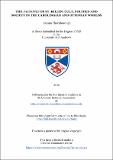Files in this item
The 'Passiones' of St. Kilian : cult, politics and society in the Carolingian and Ottonian worlds
Item metadata
| dc.contributor.advisor | Palmer, James T. (James Trevor) | |
| dc.contributor.author | Thornborough, Joanna | |
| dc.coverage.spatial | v, 202 p. | en_US |
| dc.date.accessioned | 2015-07-09T15:48:02Z | |
| dc.date.available | 2015-07-09T15:48:02Z | |
| dc.date.issued | 2015-06-25 | |
| dc.identifier.uri | https://hdl.handle.net/10023/6953 | |
| dc.description.abstract | The subject of this thesis is the relationship between hagiography and cult in the early medieval west taken through the example of the Passiones of St. Kilian of Würzburg († 689) in the period from circa 700 to circa 1000 AD. Through examining a cult which developed east of the Rhine, this thesis will assess these developments taking place in a region without a strong Christian-Roman history. Thuringia produced new saints and cults in this period, yet they all operated within the overarching framework of the well-established religious phenomenon of saints’ cults. In its approach, this thesis builds upon the insights of Ian Wood, James Palmer and others, in which saints’ Lives are viewed as ‘textual arguments’ which could operate beyond cultic contexts. This is combined with the cultural context approaches advocated in geographically specific studies by the likes of Julia Smith, Thomas Head and Raymond Van Dam. By paying particular attention to the impact of updating saints’ Lives this thesis provides an in depth comparison of the relatively overlooked two earliest passiones of St. Kilian and their place in the history of the Würzburg community. It therefore addresses the nature and function of hagiography and its relationship with the institutional memory and identity of that community. The spread of cult through texts and relics is compared with the distribution of the hagiography in order to form a picture of the relationship between these different facets of cult. The question of the way in which these passiones engaged with their wider political and religious contexts is also addressed in order to demonstrate the functions of hagiography outwith an immediate cultic context. | en_US |
| dc.language.iso | en | en_US |
| dc.publisher | University of St Andrews | |
| dc.rights | Creative Commons Attribution-NonCommercial-NoDerivatives 4.0 International | |
| dc.rights.uri | http://creativecommons.org/licenses/by-nc-nd/4.0/ | |
| dc.subject | Cult | en_US |
| dc.subject | Hagiography | en_US |
| dc.subject | Würzburg | en_US |
| dc.subject | Carolingian | en_US |
| dc.subject | Ottonian | en_US |
| dc.subject | Kilian | en_US |
| dc.subject | Mission | en_US |
| dc.subject | Jezebels | en_US |
| dc.subject | Saints | en_US |
| dc.subject | Early Middle Ages | en_US |
| dc.subject | Thuringia | en_US |
| dc.subject | Memory and identity | en_US |
| dc.subject.lcc | BR1720.K54T5 | |
| dc.subject.lcsh | Hagiography | en_US |
| dc.subject.lcsh | Kilian, Saint, -689? | en_US |
| dc.subject.lcsh | Christian saints--Cult | en_US |
| dc.subject.lcsh | Christian hagiography--History--To 1500 | en_US |
| dc.title | The 'Passiones' of St. Kilian : cult, politics and society in the Carolingian and Ottonian worlds | en_US |
| dc.type | Thesis | en_US |
| dc.contributor.sponsor | Arts and Humanities Research Council (AHRC) | en_US |
| dc.type.qualificationlevel | Doctoral | en_US |
| dc.type.qualificationname | PhD Doctor of Philosophy | en_US |
| dc.publisher.institution | The University of St Andrews | en_US |
This item appears in the following Collection(s)
Except where otherwise noted within the work, this item's licence for re-use is described as Creative Commons Attribution-NonCommercial-NoDerivatives 4.0 International
Items in the St Andrews Research Repository are protected by copyright, with all rights reserved, unless otherwise indicated.


